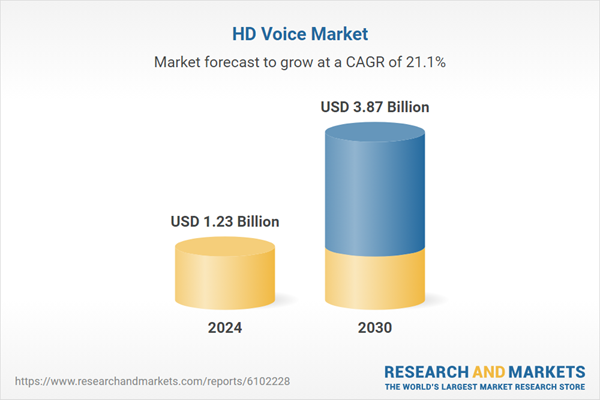Speak directly to the analyst to clarify any post sales queries you may have.
10% Free customizationThis report comes with 10% free customization, enabling you to add data that meets your specific business needs.
Key Market Drivers
Proliferation of 4G LTE and 5G Networks Enabling HD Voice Transmission
The rapid rollout of 4G LTE and 5G networks worldwide is a critical factor propelling the adoption of HD Voice services. These advanced mobile infrastructures support packet-switched data transmission and wideband audio capabilities, delivering improved clarity and reduced latency in voice communication. Unlike legacy circuit-switched systems, modern networks accommodate the broader frequency ranges required by HD Voice technologies. Telecommunications providers are increasingly integrating VoLTE and VoNR (Voice over New Radio) functionalities to enhance call quality and user experience. This shift is especially notable in digitally transforming regions where smartphone usage is accelerating. As users upgrade to next-generation networks, expectations for high-quality voice services rise, making HD Voice an essential offering for service providers aiming to remain competitive and meet customer demands.Key Market Challenges
Interoperability Issues Across Networks and Devices
A major challenge limiting the widespread adoption of HD Voice is the lack of interoperability across various networks and devices. Although technologies such as VoLTE and VoNR are becoming more common, consistent HD Voice performance remains difficult to achieve globally. Compatibility issues between devices, varying codec support, and discrepancies in network infrastructure often result in downgraded call quality when either party lacks HD Voice capability. This is particularly problematic in emerging markets, where older or low-cost devices may not support wideband audio. Furthermore, seamless HD Voice requires compatible infrastructure at both ends of a call, and if one is connected via a legacy network, the conversation defaults to narrowband. These inconsistencies hinder user satisfaction and stall the broader adoption of HD Voice solutions.Key Market Trends
Integration of HD Voice in Unified Communications Platforms
A key trend shaping the HD Voice Market is its integration into unified communications platforms used by enterprises for streamlined collaboration. Leading communication tools such as Microsoft Teams, Zoom, and Cisco Webex are now embedding wideband and super wideband codecs to enhance voice clarity and user engagement. This development supports remote and hybrid work models by improving call quality across various devices and bandwidth conditions.HD Voice enhances audio precision during virtual meetings, reduces fatigue, and improves overall communication effectiveness. As organizations prioritize seamless, high-quality communication experiences for both internal operations and client interactions, HD Voice has transitioned from an optional upgrade to a core functionality within enterprise communication ecosystems. This trend is driving further demand for HD Voice-enabled hardware and software across sectors.
Key Market Players
- Apple Inc.
- Samsung Electronics Co., Ltd.
- Microsoft Corporation
- Alphabet Inc.
- Cisco Systems, Inc.
- Nokia Corporation
- Huawei Technologies Co., Ltd.
- AT&T Inc.
Report Scope:
In this report, the Global HD Voice Market has been segmented into the following categories, in addition to the industry trends which have also been detailed below:HD Voice Market, By Access Type:
- Mobile
- Broadband
HD Voice Market, By User Type:
- Enterprise User
- Consumer
HD Voice Market, By Application:
- Video Conferencing
- Audio Conferencing
- Web Conferencing
- Multimedia Conferencing
- Audio Broadcast
- Announcement Services
HD Voice Market, By Region:
- North America
- United States
- Canada
- Mexico
- Europe
- Germany
- France
- United Kingdom
- Italy
- Spain
- Asia Pacific
- China
- India
- Japan
- South Korea
- Australia
- Middle East & Africa
- Saudi Arabia
- UAE
- South Africa
- South America
- Brazil
- Colombia
- Argentina
Competitive Landscape
Company Profiles: Detailed analysis of the major companies present in the Global HD Voice Market.Available Customizations:
With the given market data, the publisher offers customizations according to a company's specific needs. The following customization options are available for the report.Company Information
- Detailed analysis and profiling of additional market players (up to five).
This product will be delivered within 1-3 business days.
Table of Contents
Companies Mentioned
- Apple Inc.
- Samsung Electronics Co., Ltd.
- Microsoft Corporation
- Alphabet Inc.
- Cisco Systems, Inc.
- Nokia Corporation
- Huawei Technologies Co., Ltd.
- AT&T Inc.
Table Information
| Report Attribute | Details |
|---|---|
| No. of Pages | 185 |
| Published | June 2025 |
| Forecast Period | 2024 - 2030 |
| Estimated Market Value ( USD | $ 1.23 Billion |
| Forecasted Market Value ( USD | $ 3.87 Billion |
| Compound Annual Growth Rate | 21.0% |
| Regions Covered | Global |
| No. of Companies Mentioned | 8 |









